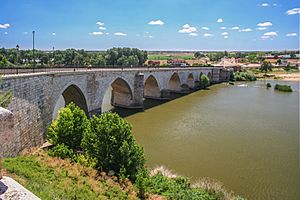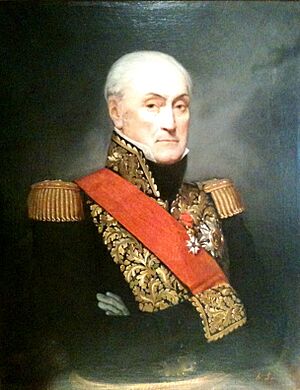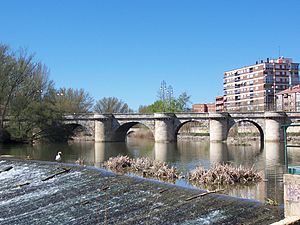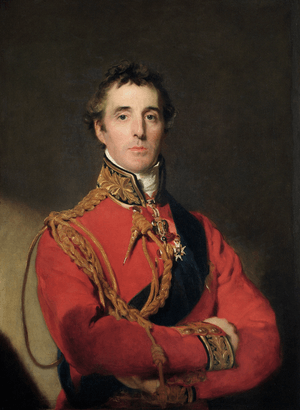Battle of Tordesillas (1812) facts for kids
Quick facts for kids Battle of Tordesillas (1812) |
|||||||
|---|---|---|---|---|---|---|---|
| Part of the Peninsular War | |||||||
 Stone bridge over the Duero at Tordesillas |
|||||||
|
|||||||
| Belligerents | |||||||
| Commanders and leaders | |||||||
| Strength | |||||||
| 53,000 | 35,000 | ||||||
| Casualties and losses | |||||||
| 350 killed, wounded or captured | 800 killed, wounded or captured | ||||||
The Battle of Tordesillas was a series of clashes that happened between October 25 and 29, 1812. It was part of the Peninsular War, which was a big conflict in Spain and Portugal. This war was itself part of the larger Napoleonic Wars across Europe.
In this battle, a French army led by Joseph Souham fought against an army of British, Portuguese, and Spanish soldiers. This Allied army was commanded by Arthur Wellesley, who was known as Marquess Wellington.
Before Tordesillas, Wellington's army had tried to capture the city of Burgos but failed. So, his 35,000 soldiers began to retreat west. The French army, with 53,000 soldiers, chased them. On October 23, French cavalry (soldiers on horseback) attacked the Allied rear guard (the part of the army that protects the back during a retreat). This fight, called the Battle of Venta del Pozo, didn't have a clear winner.
The Allied army then moved back behind the Pisuerga and Carrión Rivers. They set up a defensive line there. Starting on October 25, there were more fights near Palencia and Villamuriel de Cerrato. The French tried to get around the Allied army's northern side. Wellington then used a clever defense, which made the French pause for two days.
The turning point came on October 29. A group of French soldiers swam across the Duero River at Tordesillas. They carried their weapons on a small raft. Once they reached the other side, they attacked the soldiers guarding a key bridge. These defenders were from the Black Brunswickers, a German unit fighting for the Allies. The French surprised them and took control of the bridge. With the bridge now in French hands, Wellington had to keep retreating towards Portugal.
Meanwhile, another British commander, Rowland Hill, was pulling his troops out of Madrid. On November 8, Wellington and Hill joined their armies near Alba de Tormes. By this time, the French armies were led by Nicolas Soult. About 80,000 French soldiers faced 65,000 Allied soldiers near the old Salamanca battlefield. But neither side started a big battle. Wellington then began another retreat.
The retreat was very difficult. Many soldiers were captured or died from hunger and cold. After this tough journey, the Allied army finally settled into winter camps.
Contents
Background to the Battle
The Battle of Tordesillas happened after some important events in the Peninsular War. This war was fought in Spain and Portugal between 1808 and 1814. It was a major part of the Napoleonic Wars, where France, led by Napoleon Bonaparte, fought against many European countries.
Wellington's Victories and Challenges
On July 22, 1812, Wellington won a big victory. His army defeated Marshal Auguste Marmont's French Army of Portugal at the Battle of Salamanca. This was a huge win for the Allies. Marmont was badly hurt, and his army lost many soldiers. About 10,000 French soldiers were killed or wounded. Another 4,000 were captured, along with cannons and flags. The Allies lost fewer men, about 4,762.
After this victory, King Joseph Bonaparte, who was Napoleon's brother and the King of Spain, left Madrid. Allied forces then captured Madrid's forts on August 13. A major result of the Salamanca victory was that Marshal Nicolas Soult had to stop his two-and-a-half-year Siege of Cadiz. He also left the region of Andalusia.
Hoping to continue his success, Wellington started the Siege of Burgos on September 19, 1812. A siege is when an army surrounds a city or fort to try and capture it. Burgos was defended by about 2,000 French soldiers led by General Jean-Louis Dubreton. He defended the city very well and aggressively. During this siege, the Allies lost 2,100 soldiers but couldn't capture Burgos. They had to retreat on October 21.
French Response and Allied Retreat
While Wellington was trying to take Burgos, the French armies reacted quickly. To fight Wellington's 35,000-man army, General Joseph Souham gathered 53,000 French soldiers in northern Spain. This force included soldiers from the Army of Portugal and other French units. In the south, Marshal Soult and King Joseph advanced towards Madrid with 61,000 soldiers.
To face these large French armies, Lieutenant General Rowland Hill had 31,000 British and Portuguese soldiers, plus 12,000 Spanish soldiers. Wellington's own army had 24,000 British and Portuguese troops and 12,000 Spanish troops under General José María Santocildes.
Wellington managed to start his retreat from Burgos before Souham realized it. Souham only found out late on October 22. He immediately sent almost 6,000 cavalry soldiers to chase the Allies. On October 23, the main Allied army crossed the Pisuerga River at Torquemada. They spread out to defend the western bank of the river. On the same day, the French cavalry fought Wellington's rear guard in the Battle of Venta del Pozo. Both sides lost about 200-230 men, and the fight ended without a clear winner.
The Battle of Tordesillas
The main clashes of the Battle of Tordesillas happened between October 25 and 29, 1812.
Clashes at Palencia and Villamuriel
On October 25, Souham's French army moved forward. They attacked Wellington's center and left side, which were positioned along the Pisuerga and Carrión Rivers. The French tried to push through the center, but the British 5th Division fought them off.
However, on the Allied left side, a Spanish division was forced out of Palencia. This city was on the east bank of the Carrión River. The French chased them so closely that they crossed the Carrión bridge before the Allies could destroy it. General Maximilien Sebastien Foy's French division secured a foothold on the other side. Another French division, led by General Antoine Louis Popon de Maucune, crossed the Carrión further south at Villamuriel de Cerrato.
These French attacks threatened to cut off part of Wellington's army. So, Wellington sent four brigades (smaller groups of soldiers) to push Maucune back. After a tough fight, the French were forced out of Villamuriel. In these clashes, the French caused 800 casualties (killed, wounded, or captured) for the Allies. The French, however, lost only 350 men.
Since the French had gotten around his river defenses, Wellington made a clever move. He shifted his entire army to the east bank of the Pisuerga River. This meant that on October 23, he defended the west bank, but on October 25, he defended the east bank. He placed his left side (which used to be his right) at Valladolid. His right side was secured on a smaller river about 20 miles upstream. This created a very strong defensive position. The French General Souham was confused by this move. He ordered his troops to scout the area and thought about his next move for two days.
The Surprise Attack at Tordesillas
On October 29, General Foy's forces made another successful move. A brave French officer named Captain Guingret led 54 men from the 6th Light Infantry Regiment. They swam across the Duero River at Tordesillas. They silently pulled a raft with their weapons across the river. Once they reached the other side, they quickly grabbed their muskets.
They then attacked the soldiers guarding the bridge. This guard was a small group of soldiers from the Black Brunswickers. The Brunswick officer and his men were completely surprised and attacked from an unexpected direction. They quickly fled, allowing the French to capture the bridge without losing any men. They even took nine prisoners.
Capturing this bridge to the west of Wellington's position was a big problem for the Allies. It broke Wellington's defensive line. Even though Wellington managed to stop the French from expanding their control beyond the bridge, he was forced to order a full retreat.
The Long Retreat
After the Battle of Tordesillas, the French pursuit slowed down. General Marie-François Auguste de Caffarelli du Falga took 12,000 soldiers from the Army of the North and went back to the Bay of Biscay coast. He needed to deal with new Spanish guerilla attacks there.
Following Wellington's orders, General Hill left Madrid on October 31, 1812. Hill's 4,000-man rear guard held off Soult's leading troops at the Aranjuez bridge on October 30. A week later, Hill joined Wellington near Alba de Tormes. Meanwhile, Souham's army joined Soult's on November 8.
On November 10 and 11, the two armies had small skirmishes along the Tormes River near Alba. Twelve companies of French light infantry and the 45th Line Infantry Regiment were pushed back. They were stopped by Brigadier General Kenneth Howard's brigade. This unit included British and Portuguese regiments. The French lost 158 men, while the British and Portuguese lost 113. Because of this setback, Soult's army crossed the Tormes further south, and Wellington had to fall back again.
On November 15, a huge force of 80,000 French soldiers faced 65,000 Allied soldiers. They were on the same ground where the Battle of Salamanca had been fought. To the anger of his own soldiers, Marshal Soult did not order an attack. Instead, Wellington began retreating that afternoon.
As the Allies marched away, it started to rain constantly. The supplies in the Salamanca depots were quickly packed up and sent away. But Wellington's supply system completely broke down. Luckily for the Allies, King Joseph had forbidden most of his army from chasing them, only allowing cavalry. On November 16, at Matilla de los Caños del Río, Brigadier General Victor Alten and 1,300 men fought 2,000 French cavalry. Alten's troops included German and British cavalry, plus two cannons. The French lost 50 men, mostly wounded and captured. Alten's command had 34 casualties.
The Allied soldiers were already feeling down because of the retreat. Soon, they had to survive by eating acorns. This was because the Quartermaster General, James Willoughby Gordon, accidentally sent the supply trains down the wrong road. On November 17, Gordon also sent the cavalry protecting the rear off to the side. For a while, the retreating foot soldiers were directly exposed to French cavalry attacks. On this day, Wellington's second-in-command, Edward Paget, was captured by the French horsemen. The hungry soldiers suffered greatly as they marched on muddy roads in the cold weather.
During the retreat, three of Wellington's division commanders made their own decisions. Lieutenant General William Stewart and two others decided not to follow Wellington's direct order about which road to take. Stewart was joined by Lieutenant General Lord Dalhousie and either Major General John Oswald or Lieutenant General Henry Clinton. When Wellington found them the next morning, their three divisions were in total chaos. Later, when asked what he said, Wellington replied, "Oh, by God, it was too serious to say anything." On November 16, French cavalry rounded up 600 soldiers who had fallen behind. The next day, they captured even more.
The Allied army finally reached their base at Ciudad Rodrigo on November 19. Two-fifths of the army's soldiers were either sick or missing. The soldiers were not happy when Wellington sent a harsh letter to his commanders, which was then leaked to the newspapers. A total of 5,000 men were missing. Many of them were on their way to French prison camps. But most had died from starvation or hypothermia (being too cold).
Even though the Allied army seemed defeated, they had actually achieved a lot in 1812. The French had been forced out of important cities like Ciudad Rodrigo, Badajoz, Seville, and Astorga. They had also lost control of several regions in Spain, including Andalusia, Extremadura, and Asturias.





